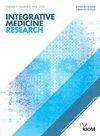Predictors of the intention to use integrative medicine in psychiatric hospitals
IF 3
4区 医学
Q2 INTEGRATIVE & COMPLEMENTARY MEDICINE
引用次数: 0
Abstract
Background
The present study aimed to examine the influence of psychosocial and demographic factors on health professionals’ intention to integrate complementary and integrative medicine (CIM) into hospital-based psychiatric clinical practice. It also sought to validate the theoretical model derived from our previous exploratory study.
Method
A cross-sectional survey study using an online questionnaire sent to 4111 potential participants based on an adapted version of Triandis’ Theory of Interpersonal Behaviour (TIB).
Results
Participants reported high levels of positive attitudes towards CIM, with 61.6 % of the 1561 respondents reporting previous use in clinical practice and 37.8 % having received formal CIM training. Analysis of professionals’ intention to use CIM revealed four influential psychosocial factors - affect, perceived social norms, descriptive norms and past behaviour (p < 0.0001) - and three significant demographic factors - older age, a managerial position and fewer years of clinical practice (p < 0.05). With an area under the ROC curve of 95.53 %, the resulting model showed high discriminatory power and excellent fit.
Conclusions
These findings highlight the need for a supportive institutional environment to promote CIM. This requires the support of a wide range of professional leaders and the promotion of a shared CIM culture among healthcare professionals and interdisciplinary discussions.
精神病院使用中西医结合治疗意向的预测因素
本研究旨在探讨社会心理和人口因素对卫生专业人员将补充和结合医学(CIM)纳入医院精神病学临床实践的意向的影响。它还试图验证从我们之前的探索性研究中得出的理论模型。方法基于Triandis人际行为理论(TIB)的一个改编版本,采用一份在线调查问卷对4111名潜在参与者进行横断面调查研究。结果1561名受访者中有61.6%的人在临床实践中使用过CIM, 37.8%的人接受过正式的CIM培训。对专业人员使用CIM意向的分析揭示了四个影响心理社会因素——情感、感知社会规范、描述性规范和过去行为(p <;0.0001),以及三个重要的人口统计学因素——年龄较大、管理职位和临床实践年数较少(p <;0.05)。该模型的ROC曲线下面积为95.53%,具有较高的判别能力和良好的拟合效果。结论:这些发现强调了促进CIM的支持性制度环境的必要性。这需要广泛的专业领导的支持,并在医疗保健专业人员和跨学科讨论中促进共享CIM文化。
本文章由计算机程序翻译,如有差异,请以英文原文为准。
求助全文
约1分钟内获得全文
求助全文
来源期刊

Integrative Medicine Research
Medicine-Complementary and Alternative Medicine
CiteScore
6.50
自引率
2.90%
发文量
65
审稿时长
12 weeks
期刊介绍:
Integrative Medicine Research (IMR) is a quarterly, peer-reviewed journal focused on scientific research for integrative medicine including traditional medicine (emphasis on acupuncture and herbal medicine), complementary and alternative medicine, and systems medicine. The journal includes papers on basic research, clinical research, methodology, theory, computational analysis and modelling, topical reviews, medical history, education and policy based on physiology, pathology, diagnosis and the systems approach in the field of integrative medicine.
 求助内容:
求助内容: 应助结果提醒方式:
应助结果提醒方式:


